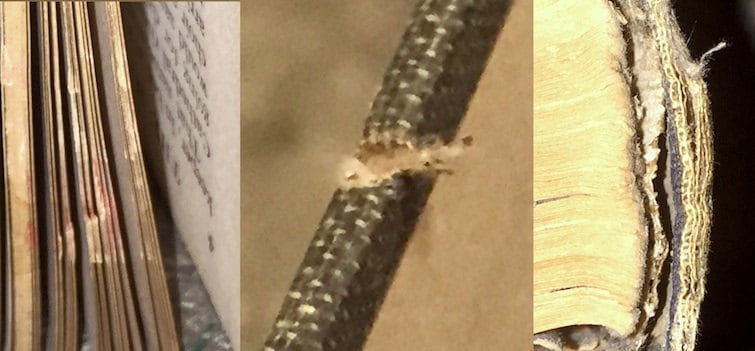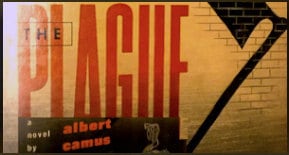While librarians and archivists have at their disposal many sophisticated tools and techniques applicable to the subject at hand, the discussion and recommendations that follow are intended for individual book collectors and describe methods requiring only common household products and readly available tools.
The best way to keep book lice out of your library is to eliminate their food source. Book lice feed on tiny bits of fungal residue⎯⎯⎯⎯in other words, mold. While mold spores are omnipresent, books are generally at risk of infection only in the presence of moisture or other items and surroundings which are already infected. For instance, mold in the walls or ceilings of a room or on an old wooden bookcase could easily contaminate books nearby. But most mold problems, insofar as they relate to books, seem to begin with the purchase of a dirty book that is ingenuously placed on the shelf with the rest of the collection.

Damage to textblock edge (left) and binding (right)
Nobody intends to buy moldy books but it's an easy mistake to make, especially when you're buying books in quantity or with urgency (as, for example, at a crowded library sale), in lots at auction, or on the Internet. It's best to inspect each newly purchased book individually before it gets close to your collection. And be sure to check the boards under the book's dust jacket if it has one⎯I've discovered horrible hidden mold infections lurking under the dust jacket on books that have been sitting on my shelf for years. If you catch a whiff of mold emanating from a book, even if you don't see any spores, you should generally take a pass.
However, it sometimes happens you find a book you really, really want, or maybe just a book that's really valuable, except it smells like a dead possum in a toilet. If the boards or pages have become fuzzy or turned a different color you should resist the urge, however strong, to take it home (though it may be possible and worthwhile to extricate an unaffected dust jacket around it). However, as long as the mold is confined to the text-block edges you might be able to redeem it with a bit of effort.
Sandpaper
What I do when I find a book like this is take a sandpaper sponge and scrape back and forth along the text-block edge, physically removing the mold spores. Make sure to pinch the pages firmly together while moving the sponge along. This action itself is liable to deprecate the book's condition so it's probably a worthwhile measure only for books you regard as necessary or irreplaceable. Make sure that all dust is removed before replacing the book on the shelf.
Dehumidifier
For any book issue involving mold or bugs, a dehumidifier is an indispensable tool. You can get a decent unit for about 200.00$ new or 50.00$ used. In regions with excessive humidity a dehumidifier should be used consistently in order to proactively forestall mold and bug problems. But a dehumidifier can be put to good remedial use even for those already in the throes of pestilence.
Place the dehumidifier in the center of the library or book room, and close any doors or windows. If you have any portable fans to spare, move them into the library and turn them up to their highest setting. You may also want to move the dehumidifier every couple of hours. The idea is to eliminate any pockets of moisture in the room. I let the dehumidifer run until the hygrometer consistently levels out at 25% relative humidity. Note that this is much drier than you ordinarily would want the air around your books to be. In my experience it takes twenty four hours or so to get a 500 square foot room down to this level (using a consumer-grade 70-liter unit) but of course this will vary by climate, the size of your collection, and so forth.
What's great about a dehumidifier is that it doesn't simply cause the bugs to die inside the books. Instead, as the room becomes progressively drier, the insects begin to dessicate and will seek out any moisture in the room, leaving the books behind. If there's a sink in the room you will notice a mass of dead insects coalescing around the porcelain. It might be helpful to set a basin containing a very small amount of water in the room while the dehumidifier is operating to coax the bugs out of hiding.
If you have any fancy leather-bound volumes or other books that are sensitive to dryness I would advise you to take them out of the library before you start up the dehumidifier. I have not experienced any adverse effects in this regard personally but it is probably best to be cautious.
Silica Gel
Silica gel is a book-safe pest-control and moisture-control product that can provide immediate effectiveness and residual protection on both counts. It is a potent dessicant, meaning it sucks the moisture out of anything it comes in contact with, including bugs. Silica gel is generally sold as granules enveloped in packets or as an extremely finely ground powder in duster canisters⎯⎯the latter is what you want. For prophylactic purposes, you should spread it around the bases, corners, and edges of bookshelves as well as any point of contact between the ground and furniture on which books are stored. For books stored in boxes, it is best to spread the gel around the edges of empty boxes and under flaps on the bottom before placing the books inside. The idea is to build a sort of moat around the books which would kill any bugs wandering in. (Note: It is possible for silica gel to become saturated in areas of excess moisture causing it to lose its effectiveness; in such situations, it must be vacuumed up and replaced periodically.)
To treat individual books suspected of harboring book lice, I use a small paintbrush to wipe the gel along the covers, joints, inner hinges, and textblock edges. Then I stand the book up, fan the pages, and puff the powder on to the exposed leaves and through the spine hollow from both the head and tail ends. (This should be done outside the library.)
In my experience, silica gel is a much more effective pest control confection than diatomaceous earth or borax (except for cockroaches) and as a dessicant it also eliminates moisture problems that attract insects in the first place. It can cause breathing problems for humans and pets, however, so exercise great care not to inhale the powder while dusting or allow it to collect within the reach of children or animals. Also be advised that along with water, silica gel will absorb any lingering liquid pesticide or other toxic residue in its proximity; if the powder is thereafter blown into the air or otherwise aerosolized it could present a serious health hazard.
Vacuum Cleaner
After moisture, dust is the factor most likely to exacerbate problems with mold and book lice. So, having just recommended the introduction of (one kind of) dust into the library to treat issues involving mold and book lice, I now turn to the elimination of dust from the library. Dust particles act as vehicles for mold spores and cause an infection to propagate and disseminate much more quickly. I use a vacuum cleaner hose attachment covered with cheesecloth or similar material to remove dust from books and shelves without damaging the books. (NOTE: it's preferable to use a vacuum equipped with a HEPA-filter as otherwise you might end up further dispersing the spores.)
Blow Dryer
For dealing with book lice on a book-by-book basis, I also like to use a blow dryer. First I move the affected book out of the library and into the garage or yard. If the book has a dust jacket, I take it off. I set the blow dryer to the low setting and the temperature to hot. Keeping the dryer about twelve inches from the book, I gently blow air over the book's boards and along the spine tips, endpapers, and hinges. Using my free hand to riffle the pages, I then blow along the text-block edges. You should be able to see the book lice pop into the air as they're physically blown from the pages. Be careful though: you don't want to use so much heat that the book is physically hot to the touch as you could warp the boards or cause the pages to undulate.
What you probably shouldn't use:
Microwave Oven
There are several reasons why this is a bad idea. First, any metal content in the book⎯⎯including gilt-edge pages⎯⎯can start a fire. Second, any glue in the book is liable to liquify, compromising the binding. Third, microwave radiation simply does not kill bugs. I have reached this conclusion after very extensive personal experimentation.
Freezer
Yes, it is possible to freeze book lice to death. The book must be enclosed in a vacuum-sealed plastic bag and left in the freezer for at least a week. This method is feasible for one or two books; for a library, or even a shelf of books, it is risky and tedious.
Pesticide
You don't want to douse your books in bug spray. It may be appropriate to treat furniture with pesticide sprays, but remember to carefully wash any exposed surfaces afterwards. Bleach works just as well as any pesticide and will effectively kill mold at the same time. However, I would reserve these options as a last resort.
